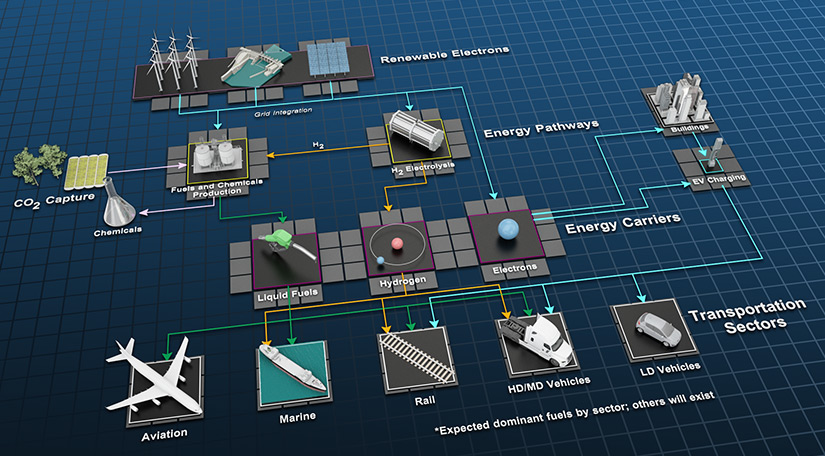Lighting the Path to Net Zero: NREL's Research Strategy Drives Deep Transportation Decarbonization
From Passenger Cars to Commercial Trucks, Aircraft, Marine, Rail, and Mobility Systems, NREL’s Whole-System Approach Ensures a Sustainable, Resilient, and Equitable Climate Future
The transportation sector is the largest source of greenhouse gas emissions in the United States, accounting for about 28% of total carbon emissions. Turning that metric to zero stands as a critical task in the global push to drive down emissions to avoid the worst impacts of climate change.
According to the Intergovernmental Panel on Climate Change, greenhouse gas emissions must be reduced by 50%–85% by 2050 to limit global warming to two degrees Celsius (four degrees Fahrenheit).
To help light that path to net-zero emissions, the National Renewable Energy Laboratory (NREL) has released a comprehensive vision for deeply decarbonizing transportation. It is a strategy rooted in cross-cutting research and engineering to enable industry stakeholders, communities, government agencies, and early adopters to meet their climate goals.
“At the basic level, our strategy is simple: pair the best technology with the right application—whether that’s an electrified ride to school, a hydrogen-fueled big rig, or a commercial flight powered by low-carbon biofuel,” said Chris Gearhart, director of NREL’s Center for Integrated Mobility Sciences. “We envision a mobility system fueled with clean, renewable energy, delivered directly by vehicle electrification, or indirectly by low-carbon, energy dense fuels and renewable hydrogen for those sectors, like marine and aviation, that are harder to electrify.”
A Whole-System Approach
NREL’s science-driven approach for decarbonizing transportation leverages decades of the laboratory’s clean energy research and arrives as major shifts are occurring in the 21st century mobility landscape. Fewer commuters are on the roads as telecommuting becomes more prevalent, yet the rise in e-commerce has placed greater demands on legacy freight mobility systems. The U.S. population continues to grow and age. New technologies, fuels, and business models are on the horizon, forcing a reevaluation of “normal.”
“The spectrum of technological, social, and environmental shifts happening today requires a novel research agenda,” said Johney Green, associate laboratory director for NREL’s Mechanical and Thermal Engineering Sciences. “As the only federal laboratory dedicated to research, development, commercialization, and deployment of renewable energy and energy efficiency technologies, NREL takes a whole-systems approach to solving energy challenges with long-term trends in mind, providing a roadmap of integrated technologies and energy pathways to get us to our destination.”
In NREL’s vision, adapting to such shifts and meeting the call to reduce emissions demands a research mindset that looks beyond individual technologies. Rather, it is a multi-pronged strategy that provides the scientific building blocks for advancing important research and engineering priorities, such as:
- Accelerating innovations in vehicle technologies, such as increased vehicle electrification (batteries and fuel cells), connectivity, and automation
- Increasing transportation efficiency by reducing emissions and decarbonizing transport across the light-, medium-, and heavy-duty vehicle; rail, aviation, and marine sectors
- Maximizing future use of renewable electrons through time- and sector-shifting, a process encompassing storing renewable electrons as hydrogen, liquid fuels, and chemicals (to be used in long-term storage)
- Optimally integrating transportation with buildings, the grid, and renewables to realize system-wide benefits.

Fueled by Leading Experts
Long a leader in transportation decarbonization research, NREL’s leading scientists and cutting-edge facilities have prepared the laboratory to innovate emerging technologies and trends from a variety of angles.
“The collective knowledge and expertise at NREL is astounding,” said Zia Abdullah, NREL’s bioenergy laboratory program manager. “In NREL’s bioenergy program, for example, we have chemists studying the fundamental chemistry of converting biomass and waste materials into fuel. Down the line, analysts look at that process in terms of economics and strategies for accelerating deployment. Others study how to optimize that fuel for use in advanced low-emission engines for ground transportation, as well as achieving higher performance (than conventional fossil fuel) in jet engines for commercial aviation.”
Like bioenergy, hydrogen sits at the center of NREL’s strategy for a transportation system decoupled from carbon emissions. While today’s market for hydrogen as a transportation fuel is limited to California and parts of Hawaii and the East Coast, experts at NREL think it will play an increasingly key role across the country to store energy and provide the emissions-free muscle needed for heavy-duty trucking, rail, and marine freight.
“Hydrogen is an abundant and highly effective energy carrier, and with support from DOE’s Hydrogen and Fuel Cell Technologies Office we have shown how to harness its potential in sectors that are more difficult to decarbonize,” said Keith Wipke, laboratory program manager for NREL’s Fuel Cell and Hydrogen Technologies Program. “We anticipate rapid advances in hydrogen fueling infrastructure, next-generation electrolysis technologies, larger-scale deployment of green hydrogen production, and durable, low-cost fuel cell systems, which we think will make it competitive in multiple markets across the nation.”
The laboratory’s success to date has been supported by an integrative research network spanning the realms of computational science, hydrogen and fuel cells, mobility sciences, urban and behavioral sciences, energy systems integration, and bioenergy, to name a few. So, while some NREL experts may specialize in vehicle-level challenges—whether to improve battery performance in electric vehicles or formulate biofuels that improve performance and reduce emissions—other researchers analyze technologies with critical system-level questions.
How might resource availability affect the economics of producing low-carbon, sustainable aviation fuel? What is the best way to integrate fueling and charging infrastructure with buildings, energy storage, and renewable energy sources? Do stakeholders, fleets, and communities have the resources and expertise they need to realize the benefits of advanced vehicles, fuels, and technologies?
“NREL has a collaborative culture that has proven highly successful in removing the technical barriers that accelerate getting new technologies into the market,” Gearhart said. “There are few technical challenges we can’t overcome when our mobility decarbonization team of 600 world-class scientists, engineers, and analysts with a passion for developing and deploying clean energy solutions put their minds to it.”
In the race against climate change, NREL’s multi-disciplinary research team—driving a strategy that attends to both small details and entire systems—will be essential to significantly cut carbon and transform the transportation ecosystem. It could be the linchpin to making that future a more sustainable, resilient, and equitable one too.
Learn more about NREL's transportation and mobility research, bioenergy research, and fuel cell and hydrogen research.
This article has been updated to reflect an editorial change made after its original publication.
Last Updated May 28, 2025

